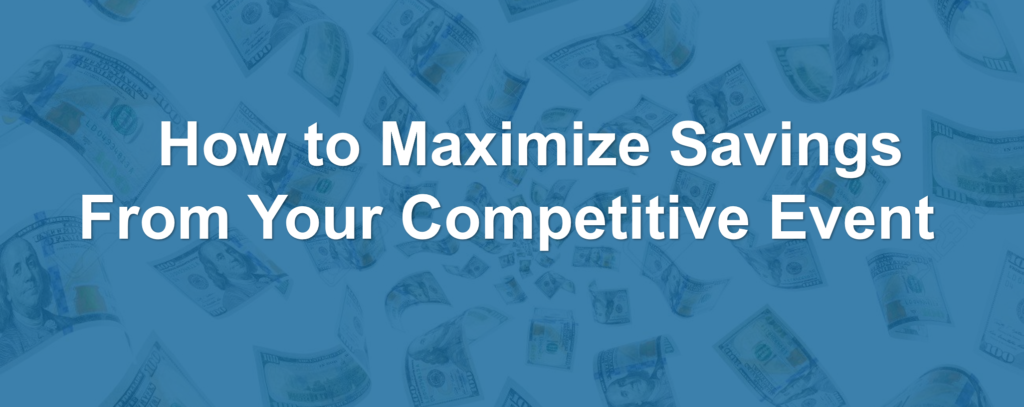
If you’re thinking about running an online reverse auction or other competitive event to drive better savings for your company, you’re already ahead of the pack. Far too often companies don’t invest the time and effort required to really test the market and determine the best possible rates without sacrificing quality. Lots of factors can contribute to this: lack of time, your people are simply too busy to take on a full blown procurement process, lack of knowledge, it’s been years since you last tested the marketplace, you are not sure who the key players in the field are, or what the market rates should be.
Good for you! But just thinking about doing it is not enough. You need to act and apply the best practices to improve results. However, sustained investment and focus are also required to produce the very best outcome. There are lots of things you can do to dip a toe in and start to improve savings.
At AIQ, we have been maximizing the competitive marketplace for our clients for over 35 years. In this article, we explore some of the key practices we follow in order to drive the best results, and you can apply them in your own project!
Here are several factors you can take into account and act on in order to produce the best results:
Pick the Right Categories to Work on
Time is precious, so spend it working on categories that will make the most impact. If you are going to take the time to create a marketplace for a particular buy, there needs to be the potential for significant savings. At the outset, AIQ examines our client’s high cost, non-employee operating and capital expenditures then compares it to our market data. We then determine what categories have the potential to produce the highest savings and return on the project.
Contract Commitments:
Most services generally run under some type of contract or commitment. Don’t allow the fact that your services are also in this position to dissuade you. For all categories AIQ addresses, we study our client’s contractual commitment to their current suppliers. We compare it against their total available spend, while we also determine what level of flexibility the existing contracts afford. There are many, many possible ways to gain the flexibility you want, even if it’s not immediately apparent. Start by making sure the services or goods you put to bid are potentially awardable to someone other than the incumbent suppliers or that you have sufficient additional buying/transformational capacity to induce your incumbent to compete for the rest of your business and concede margin as they head towards the competitive market rate.
Unfortunately, there are times albeit very rare, where the supplier has really sewed up the business in such a restrictive way that you cannot put the business out to the marketplace. An example of a very adverse position to be in would be where you just signed a 5-year contract with a 100% commitment for the 5-year term. In that case, the supplier has no reason to let you off the hook. They will likely not participate at all if you tried to run a competitive event. Conversely, the most competitive situation is when you have no contract term commitment (e.g. month to month) allowing you completely flexibility for your marketplace event.
Of course, there are other situations where an auction or competitive event is not an appropriate solution. In those cases, alternative approaches such as demand management, optimization, transformation, negotiation, and other approaches may be more appropriate. But those approaches are outside of the scope of this article. Importantly, try to avoid overcommitting or locking in your business in such a way that you have insulated the incumbent from ever having to compete. If you are unsure how to do this, please get expert advice. It’s a lot easier to preempt the problem before a bad contract is signed rather than after it’s a done deal.
Contract Timing
Contract timing can also be too short as well. We are always surprised when we learn that clients plan to renegotiate a contract at about the time it is set to expire. That planning will foreclose your options, conceding all leverage to your supplier in certain situations and so it should be avoided at all costs. Competitive events should be timed so that there is a time for a transition and that you could move from your current supplier to another supplier if you chose to do so. For example, if the contract for your company’s global data network is set to expire in a week, the supplier will know that there is simply no way you can move the services in time. In this case, there will be no incentive for the current supplier to compete. Your rates in this situation may stay the same, go down just a little bit or may even rise if your provider decides to raise them, while at the same time, the market price is plunging (remember the cost of technology goes down over time). It’s important to carefully identify, then execute the correct timing given the totality of the situation or you’ll find yourself overpaying. This is an oversimplification, but you get the idea.
Selecting the Suppliers to Invite to Bid
Now that you have chosen the categories to go to market with, it’s time to decide who to invite to bid. Unless you can’t stand your current supplier, they should usually be first on the list. When considering the rest, try to be as expansive as possible while including only those suppliers that meet your quality and performance standards. It’s certainly possible to have fierce competition with just two bidders, but generally speaking, you will get a lot more action in an auction if you have more bidders. That said, only invite suppliers you can imagine awarding some business to. If there is a supplier out there that you wouldn’t buy from even if they offered it for free, leave them out. It’s a waste of their time and yours. Certainly, there are some categories that only have a few credible potential bidders in each geographic region (e.g. mobility) while others may have hundreds (e.g. Software Development).
Create a Level Playing Field by Controlling Communications
You will get the best results when all the participating Suppliers legitimately believe that the business is there for them to either win or lose, and they rightfully understand they are all playing on a level playing field. There are several key factors that go into creating a level playing field. First and foremost, you have to control the information flow and communication with all of the participating suppliers. Here are a few ways you can do that:
- Have a Single Point of Contact (SPOC) that disseminates all information equally to the suppliers. Preferably this SPOC is not the person that typically interacts with the current incumbent supplier(s). That will help the incumbent not be in a position to exploit any personal relationships or to gain non-price/performance advantages and intel that other suppliers don’t have. In AIQ projects, AIQ acts as the SPOC during the projects.
- Don’t allow back channel communication between the Bidders and members of your team. Before suppliers are allowed to review the details of the bid, they must first agree in writing to only communicate with the SPOC. Also, prior to going to bid, instruct all levels of your organization NOT to divulge anything to suppliers and to point them to the SPOC to receive answers to their questions. Furthermore, all side communications (i.e. politicking) should be reported to the SPOC so the team can be aware of what is going on and remedy it, in order to avoid unintentional adverse consequences.
- Share the same information with all the suppliers at the same time. This includes all the details needed to provide their very most responsive bids, as well as answers to questions that each bidder might ask during the process. In other words, don’t play favorites.
Treat the Suppliers Fairly
Brute force can sometimes work but it will always leave a terrible taste in everyone’s mouth. You can anticipate that the behavior will be remembered by the supplier and the next time they are in a situation where THEY have the upper hand, they will not be likely to treat you well. There are suppliers that have participated as bidders with AIQ for over 35 years and they know that they will always be treated fairly and with respect.
Conversely, kowtowing to bad actors will only embolden them.
(Taken directly from AIQ’s playbook) “If you get a supplier with a bad attitude, pitch them out immediately. There are too many good ones waiting out there that will do a great job if you let them.”
At AIQ, we are determined to help every participating supplier be able to bring forth their very best bid. They get the opportunities AIQ brings them at absolutely no cost to them, since AIQ does not charge fees to suppliers. Instead, AIQ simply expects that the suppliers will offer our clients the best deals they can muster, and that they will act in a manner that is consistent with their promises. While servicing its clients, AIQ also helps the suppliers’ sales process. We like to think of the AIQ reverse auction as being an analytic lens through which the suppliers may understand their relative position in the market, earn greater visibility to their prospects, and at a sales cost of zero. Hence, this should be a period when the suppliers are on their very best behavior. If they act obstinate and entitled during the sales cycle, what does that predict about how they will act when you are under contract with them?
There are many other guidelines, processes, and data that AIQ has developed over 35 years of helping our clients. We hope the few listed here will help you in your own competitive events.
This article was authored by Mark W. Conklin, Principal, at AIQ.CO
